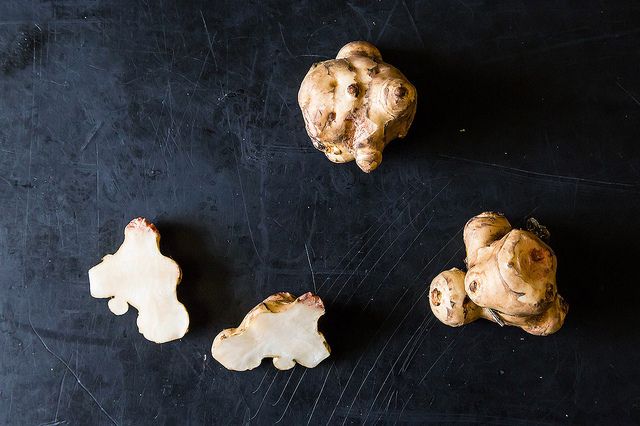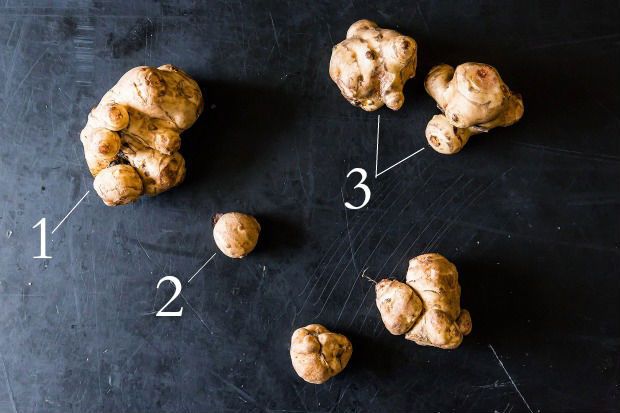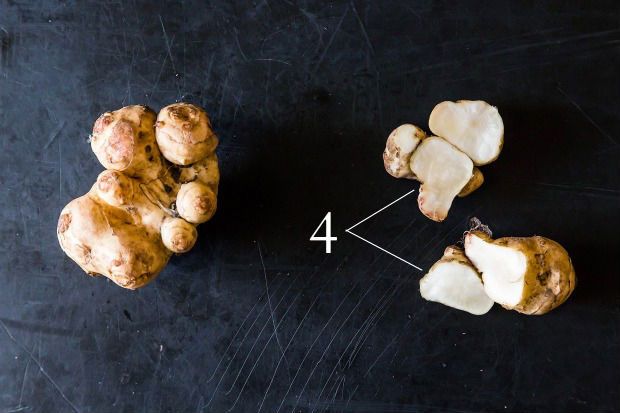Popular on Food52
Continue After Advertisement
8 Comments
LeBec F.
April 21, 2013
i just want to share a few things about jerusalem artichokes.
they certainly do not cause gassiness in everyone. For the last 20 years my family has eaten them almost daily, raw and sliced or julienned, in our green salads, and we have not had resulting gassiness. I can't say whether this is the result of eating them regularly, but i also do not remember having issues with gassiness when we first began to eat them. The funny thing is, i never knew about a connection between jer artichokes and gassiness until I read it here in this feature!
What I love about Jerusalem Artichokes (JA):
1) Their flavor- it's like a nutty carrot, with the crunchiness of water chestnuts (but none of that comparatively insipid flavor.)
2) They are so easy to prepare. Like carrots, cucumbers and potatoes, JA don't need to be peeled, and, as with most vegetables, the nutritive values are concentrated in the skin, so don't peel them! The ones we find in the market usually only need a light rinse, but if they are dirty, cut off the knobs rather than try to get out the hidden dirt, rinse the knobs, and use them with the rest of the JA tubers. While we love them in any form, we mostly eat them raw in salads, and we never bother to put them in acidulated water. They also have a refrigerated shelf life of (trust me!) months and months, stored loose in the vegetable drawer.
3) They are native to my very own country! And not only that, but to my very own region, New England, and north into Quebec! (and native nowhere else on Earth.)
4) They are exceedingly easy to grow and will readily colonize a part of your garden if allowed.
and lastly,
5) Their history: discovered(after the Native Indians) by the English settlers in MA, samples were sent back to the English royal court, where they became the fashionable rage. It is not proven, but they may have received their Latin name because of their flower; "girasole" is Latin and Italian for "turning towards the sun."
But the history behind their French name, Topinambours, is one of the most fascinating stories in the history of food. In the Age of Discovery, when explorers discovered new lands, it was common for new finds to be brought back to the explorers' homeland and presented to the sponsoring monarchs in their royal court. Pocahontas was introduced by John Smith to the royal English court, perhaps concurrently with the newly discovered JA. A few years later, a tribe of Brazilian natives was introduced to the French royal court. Coincidentally, the JA had made its way over from England and was also being presented to the French royalty at the same time.
When the French heard that "indios" had brought JA to England, they mistakenly named the tubers for the visiting Brazilian tribe, thus they became "topinambours"!!
they certainly do not cause gassiness in everyone. For the last 20 years my family has eaten them almost daily, raw and sliced or julienned, in our green salads, and we have not had resulting gassiness. I can't say whether this is the result of eating them regularly, but i also do not remember having issues with gassiness when we first began to eat them. The funny thing is, i never knew about a connection between jer artichokes and gassiness until I read it here in this feature!
What I love about Jerusalem Artichokes (JA):
1) Their flavor- it's like a nutty carrot, with the crunchiness of water chestnuts (but none of that comparatively insipid flavor.)
2) They are so easy to prepare. Like carrots, cucumbers and potatoes, JA don't need to be peeled, and, as with most vegetables, the nutritive values are concentrated in the skin, so don't peel them! The ones we find in the market usually only need a light rinse, but if they are dirty, cut off the knobs rather than try to get out the hidden dirt, rinse the knobs, and use them with the rest of the JA tubers. While we love them in any form, we mostly eat them raw in salads, and we never bother to put them in acidulated water. They also have a refrigerated shelf life of (trust me!) months and months, stored loose in the vegetable drawer.
3) They are native to my very own country! And not only that, but to my very own region, New England, and north into Quebec! (and native nowhere else on Earth.)
4) They are exceedingly easy to grow and will readily colonize a part of your garden if allowed.
and lastly,
5) Their history: discovered(after the Native Indians) by the English settlers in MA, samples were sent back to the English royal court, where they became the fashionable rage. It is not proven, but they may have received their Latin name because of their flower; "girasole" is Latin and Italian for "turning towards the sun."
But the history behind their French name, Topinambours, is one of the most fascinating stories in the history of food. In the Age of Discovery, when explorers discovered new lands, it was common for new finds to be brought back to the explorers' homeland and presented to the sponsoring monarchs in their royal court. Pocahontas was introduced by John Smith to the royal English court, perhaps concurrently with the newly discovered JA. A few years later, a tribe of Brazilian natives was introduced to the French royal court. Coincidentally, the JA had made its way over from England and was also being presented to the French royalty at the same time.
When the French heard that "indios" had brought JA to England, they mistakenly named the tubers for the visiting Brazilian tribe, thus they became "topinambours"!!
QueenSashy
April 19, 2013
Love them in theory, but much less so in practice. I am one of the folks who cannot digest sunchokes. An experience you do not wish upon your self. (And by the way, calling it gas is a minor understatement of experience you will endure upon eating.) Apparently it is a frequent problem. I also famously made a sunchoke dinner to a group of friends, without checking about their tolerance first. Another experience you do not wish upon yourself :)
Lindsay-Jean H.
April 21, 2013
Oh QueenSashy I'm so sorry -- I hope that dinner party was long enough ago that you and your friends can laugh about it!
QueenSashy
April 21, 2013
It was quite some time ago and now a fond memory :) It was a wonderful dish though, sunchokes roasted with olive oil, lavender and rosemary salt. I still swoon when I think of it. Maybe it's time to try them again in smaller quantities.
Fairmount_market
April 19, 2013
pickled Jerusalem artichokes (http://food52.com/recipes/21413-sunchoke-jerusalem-artichoke-pickles) are delicious paired with gluttonforlife's Tuscan chicken liver pate: http://food52.com/recipes/2779-tuscan-chicken-liver-pate
scott.finkelstein.5
April 19, 2013
An alternate explanation for the name: the Jerusalem artichoke is a type of edible thistle, just like the artichoke. Note this piece of writing from Amelia Simmons: "Artichokes-The Jarusalem is best, are cultivated like potatoes, (tho' their stocks grow 7 feet high) and may be preserved like the turnip raddish, or pickled -- they like,
Horse Raddish...
Horse Raddish...
LeBec F.
April 21, 2013
scott, i don't know where you got that thistle info, but i have grown jerus chokes for many yrs and thistles are nowhere to be found in their presence. maybe you are thinking of a cardoon. The jerus artichoke plant is a very tall thick strong stem topped by 2" diameter sunflower-like flowers(taxi yellow petals, brown centers; no big seeds like sunflowers. Tubers, as in potato,dahlia or daylily, grow out from the stem base, underground. Unharvested tubers will continue to multiply and readily colonize an area.They are native to New England and north into Quebec.




See what other Food52 readers are saying.